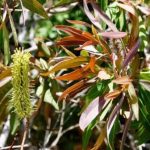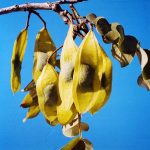TREE LIFE
JUNE & JULY 2002
AS BEFORE PLEASE CONFIRM WITH ANY OF THE COMMITTEE MEMBERS THAT THE SCHEDULED OUTINGS AND WALKS WILL ACTUALLY TAKE PLACE.
MASHONALAND CALENDAR
Saturday 6th July Botanic Garden Walk
Meet in the car park of the Botanic Garden at 10.45 for 11 am where we will meet Tom and continue with the very interesting Leguminosae, subfamily Papilionoideae.
Sunday 21st July. In the past we have had a good day’s outing at Sanganayi Creek at Mazvikadei near Banket. The owners, have agreed that we spend another day on their property, and have very kindly halved the entrance fee. So the gate fee for us will be $60 per person. We would like to express our thanks to Scripture Union for so generously giving us this concessionary rate.
Bring your lunch and meet in the carpark at 9.30am. The distance from Harare is about 110 kms.
Saturday 27th July. Mark’s next walk will be to Ewanrigg Aloe Garden in the Enterprise area. The entrance fee is $20 per person.
MATABELELAND CALENDAR
So far nothing has been arranged for July.
Contact Jonathan Timberlake if you would like to organize a future outing.
MARONDERA: 21 APRIL 2002
Sonya O’Donnell was our welcoming host to her smallholding on Laggan Rd., not far from Marondera town itself.
The area consisted of rather nice high-rainfall Brachystegia woodland. The altitude at a nearby spot height was 1689 m (or 5540 ft) so it was relatively high-altitude as well. Long fronds of grey-green lichens festooned the trees and there were numerous epiphytic orchids. The vegetation, both trees and herbs, was typical of this high-rainfall high-altitude type and was noticeably different to what we get around Harare.
As we set off, we came across the first species of interest, namely the attractive white flowers of Hebenstretia angolensis. This is a herb in the family Scrophulariaceae. It is related to the genus Selago and indeed these two (and other) genera have been separated as a distinct family, Selaginaceae. Both Selago and Hebenstretia are particularly features of the E Highlands but some representatives occur in the savannah woodland as well. Hebenstretia has a spathe-like calyx and quite prominent white flowers.
In the woodland were Cussonia arborea and C. natalensis and later we found C. spicata as well. Again, this is another feature of the Marondera area where an E Districts component enters the flora, thereby increasing the number of species seen.
Also present in the woodland was a shrubby species of Kotschya with exceptionally large blue corollas – a very striking species. Kotschya is a legume genus with its pods arranged in cone or concertina-like arrangements. This one was the slightly unusual Kotschya speciosa. We also saw K. strobilantha which occurs around Harare quite frequently – e.g. in the Mukuvisi woodland.
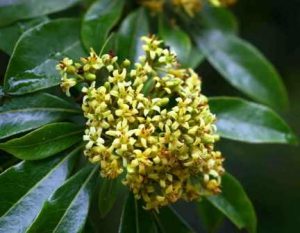
Pittosporum viridiflorum. Photo: Bart Wursten. Source: Flora of Zimbabwe
Other more common trees and shrubs seen included Psorospermum febrifugum (Christmas berry), Pittosporum viridiflorum, Indigofera rhynchocarpa (Hockey sticks), Sericanthe andongensis, Hymenodictyon floribundum and Grewia decemovulata.
In the middle of the woodland was an interesting area with a number of garden escapes (or were they perhaps planted?). Here was Acacia podalyriifolia, Cotoneaster pannosa and another species, the white Poinsettia (Euphorbia leucocephala),Duranta erecta, Tecomaria capensis and a sprawling species of jasmine.
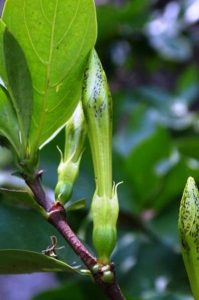
Rothmannia fischeri. Photo: Mark Hyde. Source: Flora of Zimbabwe
Nearby amongst some rocks was the shrub Rothmannia fischeri with its very distinctive domatia in the leaf axils beneath and corresponding domes on the upper surface. Also, common in the woodland was the Ivory carpet, Leptactina benguellensis and eventually after some searching a number of the characteristic ivory-coloured flowers were found, even though these were rather out of season.
Further work was spent on the old Vangueria infausta / Vangueriopsis lanciflora debate. Vangueria appeared to have the following features:
- it is hairier and not so dark green and glossy;
- the midrib is not prominent above and actually is depressed;
- the leaf lamina folds cleanly to the midrib;
- the tertiary venation is not easily visible (whether viewed from above or beneath).
In my view, one of the best characters is the presence in Vangueriopsis of brown powdery indumentum on the recent branches, whereas Vangueria has grey and non-powdery stems.
Needless to say, some of these characters are rather subjective and are not easy to work in the field. Furthermore, the plants themselves do not behave as tidily as these divisions would suggest.
Another pair of species which were examined were Clerodendrum wildii and myricoides. It appeared that wildii has smooth leaves whereas myricoides‘ leaves are either rough or hairy or both.
After a while we retraced our steps and returned encountering further different habitats and a considerable number of high-rainfall species, including Apodytes dimidiata, Cyathula cylindrica, Diospyros whyteana and Olinia vanguerioides.
Lunch took place in the shade in the Sonya’s very pleasant garden. Later everyone was given the opportunity to purchase some of her beautiful hand-made ethnic prints.
Our thanks go to Sonya. Perhaps a return visit at some time, if we may?
-Mark Hyde
BESNA KOBILA: EASTER 2002
Besna Kobila is a mountain (height 1936 m) in Yugoslavia, actually in the remote and mountainous Bossilegrad area of SE Serbia, not far from the border with Kosovo. Quite how a farm in the eastern Matopos came to be named after it is not known, but it was the Zimbabwean and not the Serbian place which was the venue for the Tree Society’s Easter outing.
Our hosts were the Stephens’ family – the brothers Gavin and Desmond, and their parents, Joan and Roy. The family warmly welcomed us and very kindly gave up most of their Easter weekend to leading us around the area.
THURSDAY, 28TH AND FRIDAY, 29TH MARCH (ARRIVAL AND FIRST DAY)
We traveled down on Thursday arriving in the late afternoon for our first look at Besna Kobila. We were staying in some converted stables – a row of comfortable rooms with stable-type doors and 2 or 3 beds in each. On the farm and the adjacent Shumba Shava Mkulu are a number of cottages which may be used by visitors and were occupied by the Stephens’ and Timberlakes. Near to the stables was a partially built kitchen with a temporary roof and some beams ready for thatch; it provided useful facilities for cooking and its open nature was very pleasant. A few yards away, a bare granite slope extends up into a low hill and the interesting plants begin !
One of the special features of Besna Kobila is that it is at a relatively high altitude (c.1480 – 1540 m in the area where we stayed) on the eastern side of the Matopos which means that it has relatively high rainfall and more mist than. It is in fact an Eastern Districts outlier like Buchwa Mtn, Bikita, Great Zimbabwe, Hwedza and Shurugwi.
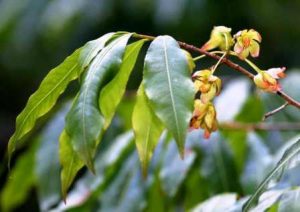
Ochna holstii. Photo:Bart Wursten. Source: Flora of Zimbabwe
The type of species recorded from there include Halleria lucida, Ochna holstii, three species of Lycopodium (definitely unusual outside the E Districts), Osmunda regalis (the Royal fern), Helichrysum spp. and Secamone alpinii.
The farm was also collected thoroughly by Oliphant Bell Miller (or OB Miller as he usually seems to be called) during the 1950s. Jonathan Timberlake had arranged for the National Herbarium to do a search for specimens collected by Miller and had made available the resulting list. This was extremely helpful, especially for the herbaceous flora.
Not much seems to be known about Miller and the circumstances in which he came to collect at Besna Kobila. The list of Botanical Collectors [1] informs us that he was born in 1882. Jonathan also told us that he wrote the standard woody plants checklist for Botswana [2]. If any reader has any further information about him, we’d be interested to know for a future Tree Life.
When I saw the list of E District species, never having been there before, I wondered in which habitats they would occur. In fact, the farm is almost like a plateau, although broken by stately ridges of granite and some larger hills, and the glory of Besna Kobila is its vleis. Large stretches of wet grassland extend throughout Besna Kobila providing an extraordinarily rich habitat. It is in the vleis (and streams) that many of the E Districts plants are to be found. Some of the higher rainfall species also occur in the kloofs at the edges of the farm, where the land becomes more broken and falls away steeply into lower parts of the Matopos. In these shady valleys, the vegetation tends to have an evergreen component.
After that very long introduction, time to report on the actual events. The first day was a local day. Gavin Stephens, who is a fundi on the Matopos (as indeed are all the family) gave us a talk setting the scene. We then walked over to Shumba Shava in the morning getting our “eyes in” for the Matopos flora.
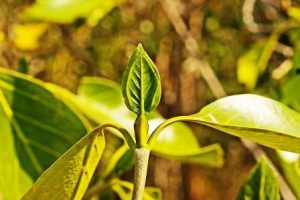
Tarenna zimbabwensis. Photo: Meg Coates Palgrave. Source: Flora of Zimbabwe
There are a number of species which are common there which we don’t get anywhere near Harare. One is Tarenna zimbabwensis. This is a Rubiaceae with the usual opposite leaves and interpetiolar stipules. The apical pair of leaves were often fused like praying hands – in the similar way that Harungana does.
Another species is the shrub Pavetta eylesii with its leaves with dark nodules and the subsp. puberula of Maytenus heterophylla with its densely-arranged spines and small leaves. A fourth is Cordia grandicalyx, which we also saw later in the weekend.
At the base of the rocky hill just by the stables were the square, winged stems of the climber Cissus quadrangularis. This was indeed a fine specimen with large and succulent stems. The odd thing about this is the very high altitude for it – it would never occur at that altitude with us.
Many times over the weekend we found Apodytes dimidiata (a high rainfall species) in many guises and were frequently confused, but I think in the end we accepted that it was just very variable. Similar variation and confusion occurred with Olinia vanguerioides. Chionanthus battiscombei, a species we don’t see every day, occurred along some of the rocky streams. It has dark green glossy leaves which are entirely hairless except for the hairy tufts (domatia) in the axils of the leaves beneath.
This day and all the days were hot, with an exceptionally strong sun and we were all very sunburnt by the end of the trip. In the evening, the temperature fell and usually a brisk and chilly breeze got up. Away from any artificial lights, the stars and a just-past-full moon were dazzlingly bright.
-Mark Hyde
Herewith a tale of one fine day in the Matopos. Saturday 30 March
What an incredible venue for the Tree Society. An amazing variety of vegetation, paths cut for easy walking and custodians who could not show us enough of their piece of paradise.
Around “The Stables” the Whitethroated Robin was very conspicuous and interesting was the overlapping of the Chinspot Batis and the Cape Batis – in the same huge Parinari.
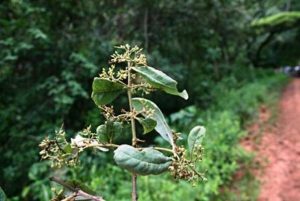
Olinia vanguerioides. Photo: Mark Hyde. Source: Flora of Zimbabwe
Saturday was a full day’s walk, along the paths with views across and into the valley below. We plunged into botany by getting straight into some confusing specimens in the gorge below the cottages, in a watercourse that would normally be very wet. Olinia vanguerioides has a very mottled bark (like a Leopard tree), a pink petiole running into the midrib with a channel down the midrib. Also Apodytes dimidiata with it’s very non-descript, crackly leaves. This area had uncharacteristically been without rain for some four months.
Sneezewood, Ptaeroxylon obliquum was abundant growing in rock fissures with masses of white fragrant flowers. It is the sawdust from the wood that is pungent and irritating and causes violent sneezing. The wood contains an aromatic resin and is also highly volatile which makes it inflammable.
A wonderful specimen of Ficus cordata was seen. It was laden with red and white fruit thickly clustered amongst the leaves. The leaves were thick and leathery with a yellow petiole and midrib. They had a waxy feel. The tree was very upright with very stubby branches and branchlets.
We sat for a breather overlooking a magnificent view of the valley while Roy Stephens gave us the historical background of the area. We saw such a variation of trees from Adansonia digitata, Cussonia natalensis, Erythrina lysistemon, Ficus verruculosa, Halleria lucida, Brachystegia glaucescens to Albzia tanganyicensis. Also Trema orientalis, a pioneer species similar to Celtis africana. The leaves of T orientalis are serrated along the entire margin whereas those of C africana are only serrated on the upper half to two-thirds of the leaf. Turraea obtusifolia was a fairly common shrub. The leaf reminded us of Karomia tettensis from the Zambezi valley and it had the typical mahogany seeds with a red aril. We saw the striking shrub Sphedamnocarpus pruriens. It has flowers that look like Ochna flowers and has hairy “helicopter” seeds. Catha edulis(Bushman’s tea) was plentiful with very leathery opposite leaves. They are serrated and the midrib was yellow. Much discussion ensued with the Elephantorriza. It was finally decided that it was in fact E burkei that was common in the rocks.
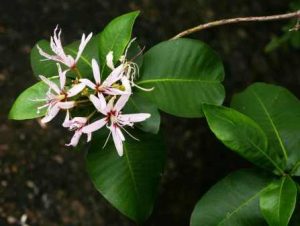
Calodendrum capense . Photo: Bart Wursten. Source: Flora of Zimbabwe
An unprecedented gallop by the Tree Society took us to a shady spot on rock where with full mouths we looked up and speculated on another Calodendrum capense (Rutaceae) complete with Citrus Swallowtail butterfly. The leaf is gland dotted and has a strong citrus smell when crushed. We wended our way lower through larger specimens of Zanthoxylum capense also the citrus family and very large Mimusops zeyheri. Z. capense has compound leaves with opposite leaflets. It looked pinnate but checking in the “book” there is a terminal leaf that “tends to abort and is often absent”. The third Rutaceae we saw was a Vepris/Teclea with a strong citrus smell and gland dotted leaves.
We were shown some interesting “grinding holes”. Some were flat and others were conical and deep. Very well preserved grain bins were in a small cave.
From this cave, the path must have been chosen by the very fit and slim Des and Gavin. We had to go through a very narrow slit between two rocks. First to attempt the gap was our illustrious chairman. There followed much mirth and an example of the national pastime as we were offered various bribes not to report in Tree Life that our chairman was well and truly stuck. He has been tardy in payment hence the report in full.
Climbing back up to higher ground we came across a wet spot with the Royal Fern Osmunda regalis giving off clouds of spore. Another stream on the way back had us on our knees examining a specimen of Lycopodium– a small fernlike Eastern Highlands plant – and learnt that the spores explode in a fire.
A wonderful day with so much seen.
-Sue and Dave du Plessis
BESNA KOBILA
Three of us went with Gavin Stephens to visit Gulubagwhe and Amadzimba Caves. We drove south with Gavin naming the kopjes and pointing out places of interest. Gulabagwhe Cave is on the right of the road opposite a grove of Julbernardia globiflora. Like half an egg set up on its rounder end in the side of a dwala. The paintings in the cave are dominated by a snake-like figure 3 or 4 metres long with a flattish belly and a humpy back. The head is on the right and bears far more resemblance to a wolf with open jaws than a snake. The tail end on the left is a skinny little curl, like a scorpion’s. Along the humpy ‘back’ of the snake are little figures of people and animals. Standing below the snakes head any sound made there is amplified, even a whisper can be heard 15 metres away as loud as normal speech. The writer knows from past experience that normal talk in the cave can be heard on top of the opposite kopje. There are various ideas on the meaning of the snake-like figure. Also in the paintings are a lot of human figures and animals. There are 2 very artistic giraffes and a very clever outline giraffe rather difficult to spot.
From Gulubaghwe we went along the Sotcha Road to see Amadzimba Cave. There is an official road to the cave but this was only apparent when we found the concrete bit sticking out from the side of the kopje. Unfortunately this route would probably be impossible to find without a guide and high clearance is vital. Amadzimba Cave is under a granite lip up on the side of Amadzimba Hill. It is well worth the drive and climb. The cave is very long with domes in the ceiling which also give interesting acoustical effects. There is a range of monochrome and bi-chrome paintings in the well known styles but also some more recent Bantu art which is literally like cut outs with a red background, having been done with very pale pigment still visible on the rock. The artistic calibre is inferior to the older art but the effect is unusual. On the floor of the cave we saw lizard and snake tracks, the belly scales of the snake clearly impressed in the fine dust where it had rested. At the back of the cave thin sheets of exfoliated granite had been stood vertically and plastered together to make large storage bins. In the drip-line were many stone tools and flakes in assorted stone not available in the vicinity. The view across the kopjes and communal land from the front of the cave was superb. We returned via a balancing rock like a beach ball on a seal’s nose.
Many thanks to Gavin Stephens for guiding us on a very worth while outing.
Adele Hamilton Ritchie.
SUNDAY, 31st MARCH
For me, this was a day spent collecting plants in the absolutely magnificent vleis. In the morning, Jonathan and I drove a few hundred metres round to the vlei near the windmill. This is a superb deep peaty vlei, drier than normal because of the unusual dry spell earlier in the year, but still with much of interest.
A large collection of plants was made – many of the usual families that one sees in Zimbabwean vleis, namely Cyperaceae and Scrophulariaceae in abundance and many Lythraceae and Poaceae. Many species of the carnivorous genera Drosera(sundews) and Utricularia(bladderworts) were found. Most of these specimens are still to be named by me.
Two species were of particular interest. One was a species in the Lycopodiaceae, Lycopodiella sarcocaulon which has peculiar thick prostrate stems from which roots descend into the soil. This was certainly new to me – although like most things, well known from Besna Kobila thanks to OB Miller.
The other was a small species of Kotschya. We often see blue-flowered species of Kotschya around Harare (two at Marondera in April, for instance) and yellow-flowered shrubby ones at Nyanga. Here, there was a small herbaceous one with white flowers and flowers arranged in a distinct head. The name is suggestive, namely Kotschya capitulifera. A very distinctive species indeed.
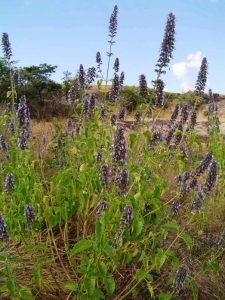
Plectranthus hereroensis. Photo: Bart Wursten. Source: Flora of Zimbabwe
Common in the whole area were the tall erect blue spikes of Plectranthus hereroensis. I tend to think of that as a high rainfall species – it is quite common for example in the areas just N of Harare, such as the Chinamora Communal Land – another outlier.
MONDAY, 1ST APRIL
We were visited by a party from Bulawayo and we walked quite a long way past Mquilembegwe along a range of rocky hills. Occasional seepage zones provided some further interesting plants, but most of this area was rather dry. The scenery was spectacular with views towards the north.
In the afternoon, I made a further collection of vlei plants in a different area this time, near the Stephens’ cottage. Here were some very large plants of Eulophia angolensis, one still bearing large yellow flowers.
Once again, the flora of this area was exceptionally interesting with a very rich vlei flora. I hope that eventually a list will be produced which combines the OB Miller records with the Stephens’ family list and the species seen on this trip.
TUESDAY, 2ND APRIL
We packed up, said and our farewells and began the long drive back to Harare. This was entirely unremarkable apart from finding an unknown yellow-flowered shrubby composite new to me from beside the main road between Bulawayo and Shangani. It must be something quite well known – but what?
All in all a marvellous weekend at a very special place. The Stephens’ are encouraging people to go and stay there, so if you are looking for a slightly different place to “get away from it all” then give it a go! I can strongly recommend it.
There are a number of unanswered historical questions relating to the name and its origin and information about OB Miller. If any readers can assist with information please let me know and we will put it in a future Tree Life.
-Mark Hyde
REFERENCES
[1] Exell, A.W. & Hayes, Gwendolen A. (1967). A List of Botanical Collectors in the Flora Zambesiaca Area. Kirkia6(1): 85-104. [2] Miller, O.B. (1948). Checklists of the Forest Trees and Shrubs of the British Empire No. 6, Bechuanaland Protectorate, (1948); The Woody Plants of the Bechuanaland Protectorate. (Journ. S. Afr. Bot. 18: 1(1952), 19: 177(1953)).BESNA KOBILA
How can you tell the men from the boys of the Tree Society? Sadly it’s not just a matter of the number of outings one has been on, clutching a tree list.
The boys / girls on the Matopos trip were seen crushing and sniffing the leaves of Heteropyxis dehniae (lavender bush). Or rushing to admire again the gently fragrant and abundant blossoms of Ptaeroxylon obliquum(sneeze-wood tree with its mildly eccentric leaves). Or pulling off sheets of bark from the musky-smelling and soft-leaved Commiphora marlothii, not to be confused with C. mollis, that doesn’t peel. Or gazing at the beautiful mottled bark of the pink-petioled Olinia vanguerioides, arching high over the rocky river bed.
Meanwhile the fundis were engaged in far sterner stuff. Not for them the 40 and 50 footers, but the knee-high stragglers with the booming names. Like Chionanthus battiscombei that never flowers, produces no seed pod that you can rattle, has a non’descript light grey bark and just remains boringly green all year under some damp and shady overhang. It’s not even armed or toxic.
But yes, I know it’s just sour grapes. I resent those who don’t need to be told a name more than six times before it sinks in. I readily admit that I tire earlier than most in the exacting science of analytical observation. That my concentration soon fades if all my senses aren’t engaged.
This is my opportunity to express my puzzlement when the initiated get so hot under the collar that a low altitude species such as Baobab appears on elevations in the North Eastern Matopos at an altitude similar to Harare’s (just under 1500m) I would have thought that if maximum temperatures attained approximate those of the middleveld rather than the highveld, that should be sufficient reason for a heat-loving seed, brought in on the wind or a wing, to take root, thrive and have its own offspring, regardless of height above sea-level.
Would you not be far more surprised to find a 1700m species growing in Weirmouth than an 1100m species growing near the top of Cecil Kop, only a few km away? Shoot me down in flames.
But I do sometimes wonder if we’re so busy classifying species with our left brain hemispheres, that we don’t even see the tree. Trees are like fragrances. We try and classify a smell, but c a can we ever pin down its essence, other than to say what it reminds us of? Perhaps we should occasionally pause and in Walter de la Mare’s haunting words,
“Look thy last on all things lovely, every hour.”
I like to ask myself, how would I look at a tree if I knew I had only a few weeks of eyesight left? Would I come round a corner and immediately dismiss that Ficus glumosa with its mighty yellow trunk and its hairy leaves clustered at the end of the branch, because I’d “done” it once already? Would I yawn at yet another Strychnos matopense with its orange berries and strange tendrils, embracing a huge expanse of boulder? Would I rather peer at esoteric glands under a lens? Or would I be a boy again?
What will irresistibly draw me back to the Matopos again is not just the challenge of making new discoveries. But rediscovering the endless variation within supposedly known species. No matter how humble or mighty your station in the Tree Society, the Matopos is sure to have something for you
And, as always, the kindness shown by those steeped in knowledge towards those less knowledgeable, is much appreciated.
-John Bennett.
NYANGA WEEKEND
Our recent weekend with the family in a holiday cottage at Nyanga was not made primarily for the purpose of looking at plants, but there were a few observations that might be of interest.
Three species of Aloe were in flower at the time (13-17 June). These were the well-known A. arborescens (bush aloe); A. cameronii var bondana(Bonda ruware aloe), and either a very late-flowering A. myriacantha (grass aloe) or a very early-flowering A. inyangensis (Nyanga aloe). I could not be positive about the latter two, and the only illustrations I had of them were inadequate for identification. The coppery-red leaves of the Bonda ruware aloe were very striking.
Another common plant in flower was Crassula sarcocaulis, looking for all the world like a bonsai. Helichrysum spp (everlasting) were everywhere, impossible to count, and-for me-impossible to separate the species.
A very dense patch of the beautiful fern Gleichenia umbaculifera was seen on the bank of a stream that was also home to a small specimen of Ilex mitis (African holly), all covered in red berries, and an even smaller specimen of Rapanea melanophleos (Cape beech).
A fierce fire had obviously swept through part of the area near the cottage, slaughtering all the young Pinus patula (patula pine) in its path. In among the dead pines I saw many specimens of Widdringtonia nodiflora (mountain cedar) of about the same size, which had been killed back to ground level by the fire, but in most cases these were sprouting again from the base. Mountain cedar is sensitive to fire, and in some parts of its local range it is found only where fire cannot get to it, but here was a clear indication that it can recover from a burn. The young pines were destroyed beyond any chance of recovery.
I was very interested to find quite a substantial amount of natural regeneration of Pinus montezumae (Montezuma pine) traceable to nine parent trees that had evidently been planted perhaps 20-25 years ago. Quite clearly this Mexican species can also become naturalized in the Nyanga region, which, as in the case of patula pine, is home from home for it. But Montezuma pine will never be as invasive as patula is. The species does not produce viable seed before the age of about 15 years (4-5 years for patula) and it does not produce cones in anything like the same quantity. The young Montezuma pines were also in the path of the same fire that had dealt so severely with the patula, but they sustained very little damage. This is a species with a built-in mechanism to protect it from fire damage-a dense cluster of thick needles surrounding each terminal bud on the branches and (especially) the leading shoot. Like all pines that are ecologically adapted to fire, the young seedlings go through what is known as a “grass stage” lasting from 2-3 years to as many as 6-7 years. During this time the plants look for all the world like dense tufts of thick grass, when the needles provide insulating protection against ground fires. Once the grass stage is over the trees grow fairly quickly to get the terminal buds out of the reach of all but the worst flames.
-Lyn Mullin
CRAZY SEASON by Peter Taylor
Lyn Mullin’s observations on unseasonal musasa flushing is interesting. I have seen the same here in Banket, and on a recent trip to Mocambique noticed musasas flushing at several places en route. A friend in the Lowveld has also noticed this on a recent trip to Harare. It seems this has been a fairly widespread phenomenon.
On a trip to Charara (28 May 2002) I noticed Combretum mossambicense on the bush-cleared power line flowering profusely, which I think is also unseasonal. As a beekeeper, these two species interest me as they are both very useful bee trees.
I remember from my sugar cane growing days in the Lowveld that floral initiations in sugar cane required three factors: the correct day light length, combined with temperature and moisture. The correct daylight hours occurred in February and August, but night time temperatures are too cold in August. Providing rain fall in February is adequate, susceptible varieties of sugar cane in Zimbabwe will flower in the winter, something cane growers don’t like as it suppresses sucrose content.
Presumably most, if not all, plants require the correct combination of day light hours, temperature and soil moisture to trigger floral initiation. From a beekeeper’s perspective it would be very useful to know what these are.
Citrus and coffee growers withhold water and subject their trees to moisture stress and, when irrigation resumes, flowers are produced in profusion – very useful to me as a beekeeper giving me a fairly reliable and predictable nectar flow.
In Retrospect Continued. Lyn Mullin
HYBRIDIZATION vs SPECIATION
From the Nyarupinda Catchment the question was asked in TREE LIFE No.139 (September 1991) whether speciation and hybridization were synonymous. No one seems to have replied to this, so, here goes. No, they are not synonymous, but hybridization may sometimes be involved in speciation. Speciation is the evolutionary development of a new species, brought about, for example, through long geographic separation from the main stock in climatic conditions that are different from those of the main stock. The evolutionary development of a number of subspecies of Gyrocarpus americanus in southern Africa, eastern Africa, and Australia would seem to be a partial process on the way to an eventual complete evolution of these subspecies into independent species. G. americanus is a remarkably stable species, and the process of the evolution of subspecies has taken an awful long time – around 135 million years. Other genera and species are less stable, eg Brachystegia, in which there is quite considerable hybridization. Where this happens, “hybrid swarms” may develop in some areas, and ultimately these may stabilize as independent species. There is good evidence of this happening in Eucalyptus and Pinus over relatively short periods. Some species in two these genera are not easily recognized. This is usually due to their more recent evolution, ie they show minimal divergence from their congeners. Such species share many characters with closely related species, and may still be exchanging genes with them via intermediate populations, or even by direct crossing.
To be continued.
TREE SOCIETY: THE FINANCIAL POSITION Mark Hyde – Chairman
The purpose of this message is to report to you on the financial position of the Society, which appears to be worse than we had realised.
Maureen reports that about 25% of the subscriptions have come in so far but that money is being rapidly spent on the now much higher cost of Tree Life and such things as the 8000 letterheads which cost $ 18 000. Rose has prepared a budget based on 200 paying members which showed what the subscriptions ought to be depending on the size of Tree Life each month. The results were as follows:
| Tree Life sides (= sheets of paper � 2) | Break-even subscription |
| 6 | $500 |
| 8 | $560 |
| 10 | $620 |
| 12 | $700 |
The actual subscriptions are $400 p.a. so we already have a serious shortfall. Furthermore, if other costs rise unexpectedly which is not unlikely, even the subscriptions mentioned above may be inadequate. In order to carry on producing an 8-page Tree Life throughout the year, an additional $ 32 000 would be needed. Indeed, more would be ideal in order to cushion us against any further cost increases which may take place.
At the Committee meeting on 16th April, we discussed what options are available to us. They appeared to be as follows:
| Option | Comment |
| 1. Increase the subscriptions now | This will be difficult given that we have only just set the rate for this year. |
| 2. Levy all the members with an extra subscription later in the year – say from 1 October 2002. | There is no precedent for this and it may well be difficult to get all members to pay. |
| 3. Cut back on Tree Life – either fewer pages and/or less frequent issues – e.g. bi-monthly or quarterly | The Committee felt quite strongly that this was not desirable. |
| 4. Fund raising for the Society | Ideas needed. |
| 5. Sponsorship | E.g. would any company sponsor an edition of Tree Life in return for some advertising. |
| 6. Allow advertising in Tree Life | Up to now we have avoided this – but should we think again? |
| 7. Request donations | A variant of 4. Above. |
| 8. Sell information | Do we have anything of commercial value? |
| 9. Produce Tree Life more cheaply | Maureen has already looked around for cheaper providers but Canon seem to be very competitive. |
In the meantime, I would like to ask all members to do the following:
- pay their subscriptions as soon as possible (this will aid the short term cash flow);
- if possible, make a donation to the Society. I appreciate that times are hard and that this may simply not be possible so don’t worry if this is not feasible
- consider whether we should allow advertising in the newsletter and/or sponsorship of a discrete sort
MARK HYDE CHAIRMAN


